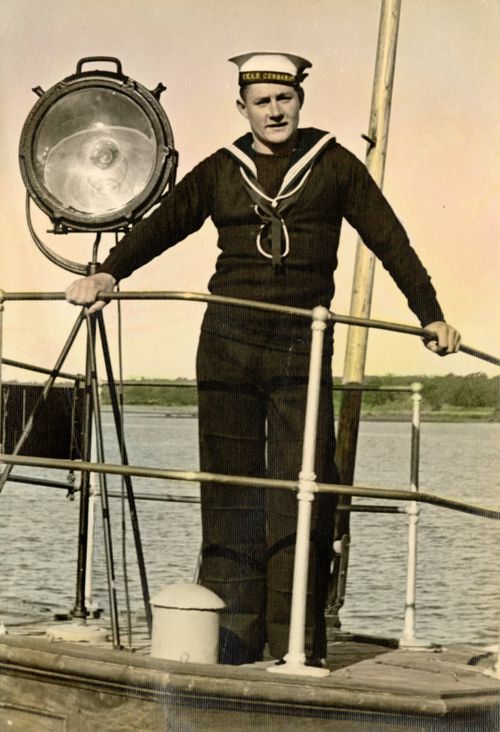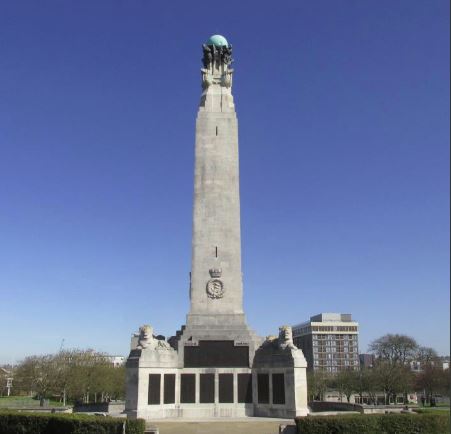Eric Gordon (Ricky) Devereux
From Our Contribution
 photos courtesy Jan Kramer | |
 | |
| Personal Information | |
|---|---|
| Date of Birth | 7 Sep 1921 |
| Place of Birth | Perth, Western Australia |
| Death | 19 Nov 1941 |
| Place of Death | Off the coast north of Geraldton, Western Australia |
| Age at Enlistment | 16 years, 7 days |
| Description | 5'6" (1.68m) tall ; ; fresh complexion ; hazel eyes ; dark brown hair ; scar over right eyebrow |
| Occupation | Mill hand |
| Religion | Congregational |
| Address | Cnr Third road & Church avenue, Armadale, Western Australia |
| Next of Kin | Father , Gordon Devereux |
| Military Information | |
| Reg Number | 22078 |
| Date of Enlistment | 30 Apr 1938 |
| Rank | Able Seaman |
| Ships Served On | |
| Ship Name | HMAS Stuart |
| Tour Dates | 29 Sep 1938 ‒ 20 Oct 1938 |
| Ship Name | HMAS Sydney |
| Tour Dates | 25 Feb 1939 ‒ 20 Nov 1941 |
| Post War Details | |
| Fate | KIA 20 Nov 1941 |
| Monument(s) |
Armadale War Memorial WA State War Memorial |
| Australian War Memorial | Australian War Memorial |
| Medals |
1939-45 Star Africa Star War Medal 1939-45 Australian Service Medal 1939-45 |
Contents
[hide]Pre War
Aged 14, Ricky worked at Curtis's timber mill in Bedfordale, remaining there for 2 years until he joined the Navy in April 1938.[1]
War Service
On entering the Navy Ricky was sent to HMAS Cerberus in Victoria to undertake general seamanship training. Completing his training on 28 Sep 1938 he was rated as an Ordinary Seaman Grade II and posted to HMAS Stuart from 29 Sep until 20 Oct 1938. This was the time during which the Stuart, which had been paid off, was reactivated at the time of the Munich Crisis. She was reactivated again later with the outbreak of war, going on to be a member of the famous 'Scrap Iron Flotilla". By then Ricky had been posted to the HMAS Sydney. On 21 Oct 1938 he resumed his training at HMAS Cerberus, remaining there until 25 Feb 1939 when he was posted to the HMAS Sydney as an Ordinary Seaman. Sydney, a Leander Class, Light Cruiser, capable of 32 knots was in Fremantle when war broke out.
Sydney remained on local patrol duties around the Australian coastline until April 1940 while based on Fremantle. The Sydney played a very minor role with the first convoy of troops sent to the Middle East, escorting the bulk of the ships that were to comprise Convoy US 1 from Sydney to Jervis Bay on the NSW coast.
She was to play a far more important role with Convoy US 2 comprising Strathaird, Dunera, Ettrick, Neuralia and Nevasa (carrying WA personnel), joining their escort in the Great Australian Bight on 19 Apr 1940. Arriving in Fremanlte on 21 Apr 1940, the convoy paused to allow local leave and to take on stores before departing on 22 Apr 1940 with Sydney and HMS Ramilles as escort. On 28 Apr 1940 Sydney was relieved by the French cruiser Suffren and turned for home.
However, before she reached Fremantle, on 1 May 1940 she received new orders requiring her to head north again to Colombo in Ceylon (Sri Lanka), accomplished after a deviation to Singapore for bunker fuel. From there she sailed via Colombo, Aden and the Suez Canal to Alexandria in Egypt where she joined the British 7th Cruiser Squadron for duty in the Mediterranean.
In the Mediterranean, the Sydney participated in a bombardment of Bardia in Libya and in the sinking of the Italian destroyer Espero. Ricky was a member of the Sydney's cutter crew that rescued many of the Italian survivors of the action. She was to withstand many attacks by enemy aircraft, to the point that she was considered a 'lucky' ship. Ricky served as a member of a 4 inch gun, part of the ship's air defences. On 8 Jul 1940 the Sydney was part of the vanguard of the British Fleet that engaged an Italian fleet consisting of 2 Battleships, 12 Cruisers, and many Destroyers. While action followed, it was inconclusive and the Sydney returned to Alexandria to replace their depleted stock of ammunition.
On 18 Jul 1940 Sydney with a Destroyer escort sailed to provide support for a destroyer flotilla operating near Greece. The next morning Sydney sighted two Italian Cruisers. Ricky's diary gives a more personal insight into the action that followed:
July 19th - At 0200 hours Dodecanese Island sighted – assumed 2nd degree of readiness. 0615 reverted to 3rd degree. 0735 enemy reported by Hyperion. Increased to 25 knots – 0815 increased to 28 knots. Approx 08:20 came abreast destroyers Havock , Hindy, Hero and Ilex. 08:25 sighted enemy cruisers – increased to full speed. At 08:28 Sydney opened fire at 20,000 yards. 08:35 Made contact with destroyers. Italian cruiser Bartolomeo Colleoni sunk at 09:20 after furious battle – 09:21 hit by shell through forward funnel – upper deck sprayed with shrapnel and splinters – Havock picked up Italian survivors 545 in all. 10:25 Sydney ceased fire as other cruiser was out of range. Before it got out of range we hit it several times – reported as badly damaged. 12:00 we passed small island on way back to Alex. 15:10 turned back to go to assistance of Havock who had been heavily bombed while picking up survivors – had been hit in engine room. Many of the Italians on board were killed besides a few of our own sailors. 16:30 joined Havock – she was doing quite a good speed although her engine room was damaged. Approx. 19:00 Sydney and destroyers heavily bombed – no hits registered. 21:00 parted company with destroyers.[2]
On 7 Sep 1940 Ricky was promoted Able Bodied Seaman and around that time the Sydney was involved in the bombardment of Italian Naval bases. Soon after the ship visited Athens for leave purposes and it spent Christmas and New Year in Malta where the Sydney was given a refit and painted. In January 1941 she was replaced in the Mediterranean by the HMAS Perth and she sailed for Fremantle via Alexandria and the Seychelles. While refueling in the Seychelles she received word from a cargo ship that it was being shelled by a raider. With incomplete location information, the Sydney was unable to locate the raider and arrived back in Fremantle on 4 Feb 1941.
The West Australian crew members were granted two weeks leave while Sydney sailed for the east coast. At the conclusion of their leave they boarded a train for Sydney NSW to rejoin their ship which then returned to its duties in West Australian waters. On 9 Apr 1941 the Sydney escorted Queen Mary from Sydney to Jervis Bay while other elements of Convoy US 10 were gathering, and the Sydney then escorted them to Fremantle. Convoy US 10 carrying 22,000 soldiers comprised the Queen Elizabeth, the Queen Mary, Mauritania, Nieuw Amsterdam, and île de France was escorted from Fremantle on 19 Apr 1941 by the Australian cruisers Australia, Canberra, and Sydney.
In June 1941 Ricky's role in the ship changed to Seaman Torpedo. Perhaps, given the description of the battle in which the Sydney was destroyed (see below), this was to be a fatal move for him.
On 8 Aug 1941 Sydney providing escort for the Awatea whose destination was Canada's west coast with Australian aircrew aboard. From Sydney harbour they travelled to Auckland, and then Suva after which the Sydney returned to Australia. In October 1941, the Sydney provided an escort for the Mariposa on its first leg of the journey (as far as Auckland) from Sydney NSW to Canada. Her next escort duties were to accompany the Zealandia which was carrying troops from Sydney to Singapore. She took over the escort from HMAS Adelaide near Albany on 5 November and after four days in Fremantle where WA crew members enjoyed leave, they sailed north.
On 11th November, 1941, the day Sydney was to leave Fremantle harbour, Ricky was running late to get to the port, so, Arthur Saw who had a car, offered to drive him to get there on time. So together with Arthur’s brother Eldred (Odey) and Tommy Johnson (whose ship HMAS Perth was also in port), they all drove together with Ricky, and he arrived at the ship just in the nick of time before she set sail.According to members of the Saw family, Harold and the others wished they had missed the ship that day, as Ricky may not have perished!
Sydney left Fremantle that day as escort for the Australian ship Zealandia, and they rendezvoused with HMS Durban who was to take over the escort duty on 17th November in the Sunda Strait. Her task completed, Sydney then turned, and sailed for Fremantle.
A couple of days later, on the 19th November 1941, around 4pm, and about 200 kms west of Shark Bay off the coast of Western Australia, Sydney sighted what looked like a merchant ship about 20 kms away and steamed towards her. This unidentified ship turned west and headed for the open sea.
Sydney challenged the apparent merchant ship, who identified herself as the Dutch ship Straat Malakka. However, she was in fact, the German armed merchant Raider Kormoran disguised, and flying the Dutch flag.
The story told by German survivors, when Sydney was about 11,000 yards from Kormoran, there was activity around her Walrus aeroplane, which was operated by a catapult. An aerial check of Kormoran would have revealed her true identity, with her 300 mines on board and disguised guns and torpedoes. However, the flight by the Walrus was never carried out. At about 5:25pm the two ships were steaming on a parallel course about a mile apart. Sydney asked: Show Your Secret Sign (AWM) - the game was up! Conflict was inevitable! Detmers claims that he lowered the Dutch flag and raised the German one in six seconds.
The Germans story was that Sydney came too close, and parallel, only 1000 yards away, rather than approaching from the rear with all her guns ready, and she was exposed to Kormoran’s concealed gunnery and torpedoes. They claim that the crew on the Sydney were not ready for battle, the gun turrets and torpedo tubes were not manned and they could see the ship’s cook with his hat on, and no one was alarmed.
Simultaneously Kormoran fired two torpedoes. Her automatic anti-aircraft guns and rapid firing anti-tank guns played onto the Sydney’s bridge and also amidships, where the two port four-inch guns and the torpedoes were mounted. One German survivor states that the men on Sydney were being mown down on her decks by Kormoran’s guns.[3]
Ninety four of the 645 men aboard HMAS Sydney were from Western Australia, with Ricky and Peter Hill local boys from Armadale. Debate continues about the veracity or otherwise of the German crew's description of the engagement as the behaviour of HMAS Sydney and her crew is different from their training or their battle hardened instincts.
Notes
Details of the HMAS Sydney's voyages are an amalgam of information taken from Across the Sea to War Peter Plowman, Rosenburg Publishing, and the unpublished The Story of Gordon"Toosdee" Devereux MM by Jan Kramer.

